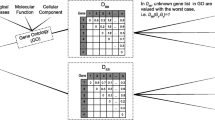Abstract
The advancement of data mining technology presents a way to examine and analyse the medical databases. Microarray data help in analysing the gene expressions, and the process of clustering helps in categorizing the data into organized groups. Grouping similar gene expressions paves the way for effective analysis, and the relationship between the expressions can be figured out. Recognizing the benefits of clustering, this work intends to present a clustering algorithm by combining generalized hierarchical fuzzy C means (GHFCM) and grey wolf optimization (GWO) algorithms. The GWO algorithm is utilized for selecting the initial clustering point, and the GHFCM algorithm is employed for clustering the microarray gene data. The performance of the proposed clustering algorithm is tested with respect to precision, recall, F-measure and time consumption, and the results are compared with the existing approaches. The performance of the proposed work is satisfactory with better F-measure rates and minimal time consumption.




Similar content being viewed by others
References
Ambroise C, McLachlan G (2002) Selection bias in gene extraction on the basis of microarray gene-expression data. Proc Natl Acad Sci 99(10):6562–6566
Breitling R, Armengaud P, Amtmann A, Herzyk P (2004) Rank products: a simple, yet powerful, new method to detect differentially regulated genes in replicated microarray experiments. FEBS Lett 573(1–3):83–92
Golub TR, Slonim DK, Tamayo P, Huard C, Gaasenbeek M et al (1999) Molecular classification of cancer: class discovery and class prediction by gene expression monitoring. Science 286(5439):531–538
Baldi P, Hatfield GW (2002) DNA microarrays and gene expression: from experiments to data analysis and modeling. Cambridge University Press, Cambridge
Hosseini B, Kiani K (2018) FWCMR: a scalable and robust fuzzy weighted clustering based on MapReduce with application to microarray gene expression. Expert Syst Appl 91:198–210
Saveetha V, Sophia S, Vijayakumar PDR (2018) Appliance of effective clustering technique for gene expression datasets using GPU. Cluster Comput 1–8
Paul AK, Shill PC (2018) Incorporating gene ontology into fuzzy relational clustering of microarray gene expression data. Biosystems 163:1–10
Dash R, Misra BB (2018) Performance analysis of clustering techniques over microarray data: a case study. Physica A 493:162–176
Balamurugan R, Natarajan AM, Premalatha K (2018) A new hybrid cuckoo search algorithm for biclustering of microarray gene-expression data. Appl Artif Intell 32(7–8):644–659
Mehmood R, El-Ashram S, Bie R, Sun Y (2018) Effective cancer subtyping by employing density peaks clustering by using gene expression microarray. Pers Ubiquit Comput 22(3):615–619
Zareizadeh Z, Helfroush MS, Rahideh A, Kazemi K (2018) A robust gene clustering algorithm based on clonal selection in multiobjective optimization framework. Expert Syst Appl 113:301–314
Liu J, Pham TD, Yan H, Liang Z (2018) Fuzzy mixed-prototype clustering algorithm for microarray data analysis. Neurocomputing 276:42–54
Swathypriyadharsini P, Premalatha K (2018) TrioCuckoo: a multi objective cuckoo search algorithm for triclustering microarray gene expression data. J Inf Sci Eng 34(6):1617–1631
Metsalu T, Vilo J (2015) ClustVis: a web tool for visualizing clustering of multivariate data using principal component analysis and heatmap. Nucleic Acids Res 43(W1):W566–W570
Chinnaswamy A, Srinivasan R (2016) Hybrid feature selection using correlation coefficient and particle swarm optimization on microarray gene expression data. In: Chinnaswamy A, Srinivasan R (eds) Innovations in bio-inspired computing and applications. Springer, Cham, pp 229–239
Alok AK, Saha S, Ekbal A (2017) Semi-supervised clustering for gene-expression data in multiobjective optimization framework. Int J Mach Learn Cybern 8(2):421–439
Scaria T, Christopher T (2018) Microarray gene retrieval system based on LFDA and SVM. Int J Intell Syst Appl 10(1):9
Scaria T, Christopher T (2018) Ensemble classification based microarray gene retrieval system. ICTACT J Soft Comput 9(1):1813–1819
Khanna D, Choudhury T, Sabitha AS, Nhu NG (2019) Microarray gene expression analysis using fuzzy logic (MGA-FL). In: Abraham A, Dutta P, Mandal J, Bhattacharya A, Dutta S (eds) Emerging technologies in data mining and information security. Springer, Singapore, pp 169–180
Hosseini B, Kiani K (2019) A big data driven distributed density based hesitant fuzzy clustering using Apache spark with application to gene expression microarray. Eng Appl Artif Intell 79:100–113
Shao G, Li D, Zhang J, Yang J, Shangguan Y (2019) Automatic microarray image segmentation with clustering-based algorithms. PLoS ONE 14(1):e0210075
Kavitha E, Tamilarasan R (2019) AGGLO-Hi clustering algorithm for gene expression micro array data using proximity measures. Multimed Tools Appl 1–15
Suo Y, Liu T, Jia X, Yu F (2019) Application of clustering analysis in brain gene data based on deep learning. IEEE Access 7:2947–2956
SivaLakshmi B, Rao NN (2019) Microarray analysis using multiple feature data clustering algorithms. In: Satapathy S, Bhateja V, Das S (eds) Smart intelligent computing and applications. Springer, Singapore, pp 469–476
Zheng Y, Jeon B, Xu D, Wu QMJ, Zhang H (2015) Image segmentation by generalized hierarchical fuzzy C-means algorithm. J Intell Fuzzy Syst 28:961–973
Pedrycz A, Reformat M (2006) Hierarchical FCM in a stepwise discovery of structure in data. Soft Comput 10(3):244–256
Karayiannis NB (1996) Generalized fuzzy c-means algorithms. In: Proceedings of the Fifth IEEE International Conference on Fuzzy Systems, 1996, vol 2. IEEE
Mirjalili S, Mirjalili SM, Lewis A (2014) Grey wolf optimizer. Adv Eng Softw 69:46–61
Freyhult E, Landfors M, Önskog J, Hvidsten TR, Rydén P (2010) Challenges in microarray class discovery: a comprehensive examination of normalization, gene selection and clustering. BMC Bioinform 11:503
Author information
Authors and Affiliations
Corresponding author
Additional information
Publisher's Note
Springer Nature remains neutral with regard to jurisdictional claims in published maps and institutional affiliations.
Rights and permissions
About this article
Cite this article
Edwin Dhas, P., Sankara Gomathi, B. A novel clustering algorithm by clubbing GHFCM and GWO for microarray gene data. J Supercomput 76, 5679–5693 (2020). https://doi.org/10.1007/s11227-019-02953-z
Published:
Issue Date:
DOI: https://doi.org/10.1007/s11227-019-02953-z




